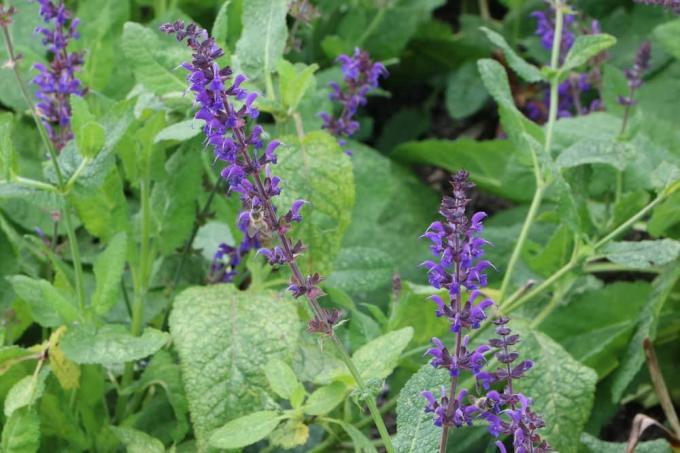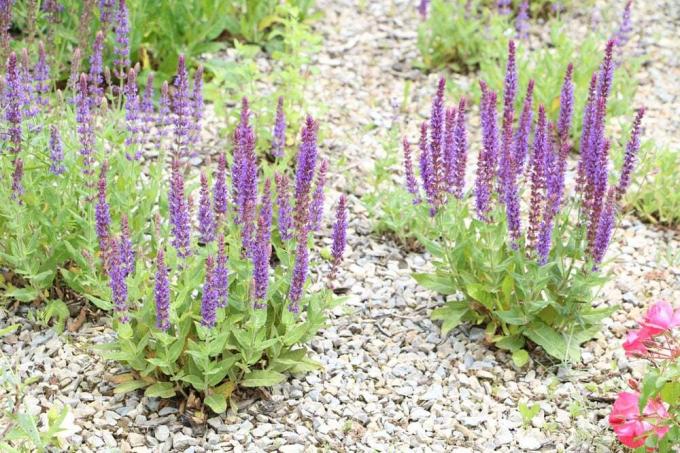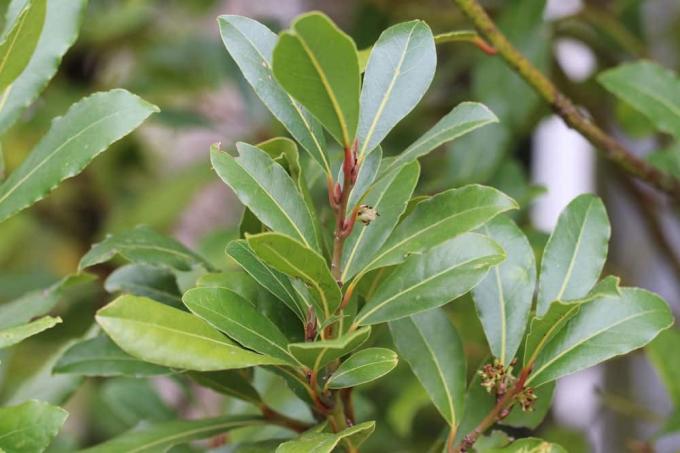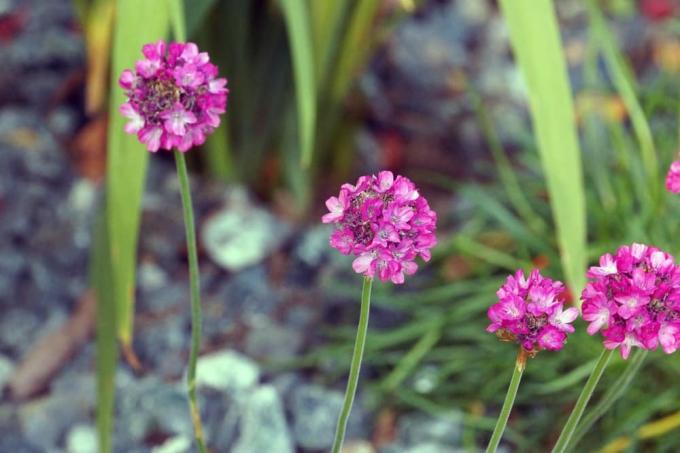

Table of contents
- Location
- Floor
- watering and fertilizing
- cut
- maintenance cut
- remount cut
- flower cut
- hibernate
- multiply
- Plant
- diseases and pests
- sorts
- plant neighbors
- Conclusion
The grove sage (Salvia nemorosa) belongs to the genus Salvia, to the mint family (Lamiaceae). New breeds are available on the market every year. Including low and higher growing varieties, from 20 to 80 cm. The evergreen steppe sage spreads its Mediterranean flair both outdoors and in pots. As a bee pasture and butterfly magnet, it is an enrichment for nature. There is also a large selection of colors, ranging from blue, violet and pink to a pure white flower.
Location
Steppe sage is at home in temperate climate zones. So it is best to give it a sunny, warm, wind-protected location. It copes well with drought. With waterlogging and shade rather not. In the company of other herbaceous perennials, in rock gardens or gravel beds, it feels particularly at home. The plants surrounding it should not tower above it, because then it no longer gets enough sun. Partially shaded places are also possible for some varieties, but the flowers may not be as lush then.
Floor
The soil for the grove sage should be permeable and rather calcareous. Heavy clay soils that tend to be damp are unsuitable. Such soils must be specially prepared for the sage. To do this, the soil is first thoroughly mixed with inorganic materials such as sand, gravel or expanded clay. Normal potting soil is used for planting in tubs, and has been enriched with a little sand beforehand. A good drainage layer in the pot is important, because here, too, waterlogging must not occur.
watering and fertilizing
If the grove sage feels comfortable in its location, further care is child's play. Regular, not excessive, watering during flowering and one or two fertilizers per year are sufficient. Compost, complete or perennial fertilizers are suitable for fertilization. Fertilize in the spring before flowering. If you like, you can fertilize again for the second flowering in July. Before that, you should give the incentive for a second flowering by pruning the faded perennial.
cut

The grove sage can be tackled twice a year with garden shears: for maintenance pruning in spring and for pruning (repair pruning) in summer. It is best not to cut in autumn after the last flowering, the old herb protects the perennial from winter frost.
maintenance cut
The main cut then takes place in the spring. Here you can cut the perennial generously into shape. This measure allows the clumps to retain a beautifully compact growth habit. Old, unsightly stems and leaves are removed. The cut can be made up to 15 cm above the ground. You should not cut into the old wood.
remount cut
The second cut is then made after the first flowering. Most of the time, this pruning will spur the grove sage into a second beautiful bloom that lasts well into fall. This measure cuts back to about a third. The second flower is not quite as lush as the main flower.
Tip:
It is best to carry out the replacement cut immediately after flowering, as soon as the flowers become limp. This prevents the plant from having to use unnecessary energy to plant the seeds.
flower cut
Anyone who has not carried out a replacement cut can gradually remove the faded inflorescences. This also promotes a longer flowering period. It also looks nicer and prevents uncontrolled self-seeding.
hibernate
When it comes to winter hardiness, there are some big differences between the different varieties of Salvia nemorosa. They are generally considered hardy down to -25°C. However, since these are always warmth-loving plants, a thin layer of brushwood is almost always advisable to protect against excessive, especially bare, frost.
Tip:
Wood sage in pots should definitely overwinter in a cool, frost-free place.
multiply
In principle, the sage plants can be propagated by sowing, cuttings and by dividing. In March you can start sowing in a warm place. When the first plant leaves appear, they can be isolated and then come outdoors from May. Propagation from cuttings is the most common in nurseries. To do this, slightly harder, but not woody, shoots are cut off about 15 cm long. Then they come under high humidity in potting soil. The first roots appear after approx. 4 weeks.
The perennial varieties of Salvia nemorosa get noticeably older and less floriferous over the years. Depending on the variety, this can already be the case after 3-4 years. Rejuvenation and propagation by division is then easy to carry out. In early autumn, the plant is dug up and the roots are carefully freed from the earth. With a clean cut you divide the root ball and both parts of the plant can be used again at the locations intended for them.

Tip:
It is advisable to divide perennial garden sage regularly, every three years. This measure keeps your sage shrub young for many years.
Plant
The sage perennials, which are offered in the garden trade, can be placed in the bed almost the entire frost-free year. The demands on location and soil must be taken into account. Many breeds are also available in seed sachets. As a rule, the cultivation of your own plants works quite well with it.
diseases and pests
A gratifying chapter: The grove sage hardly suffers any significant damage from diseases or pest infestation. Now and then spider mites or powdery mildew can appear. If so, then the plants in the bucket are more likely to be affected. On the other hand, the usual, natural means can be used to counteract this:
- mechanically with a hard jet of water
- spray with a mixture of water, soft soap and alcohol (30 ml each for 1 liter of water)
- spray with a fresh milk-water solution, 1:9 (mildew)
sorts
Below is a small selection of beautiful Salvia nemorosa varieties:
- 'Viola': deep dark blue flower, flowers early, approx. 40cm high
- 'Plumosa': flowers purple-violet, flowers densely filled, approx. 40cm high
- 'Marcus': dark violet flowers, dwarf variety, up to 25 cm high
- 'Caradonna': flowers dark blue, stems are black-violet, approx. 80cm high
- 'Amethyst': pink-violet flowers, grows stiffly upright, approx. 80cm high
- 'Blue Hill': flowers medium blue, very dense, approx. 30 cm high
- 'Ostfriesland': rich violet flowers, very robust and hardy, up to 50 cm high
- 'Adrian': flowers white and numerous, up to 60 cm high
plant neighbors

The steppe sage is a sociable plant in beds and borders. The best neighbors are plants with the same soil requirements. They must not grow too high so that they do not take away the sun from the sage. Examples of good neighbors are:
- Gypsophila (Gypsophila repens)
- low garden evening primrose (Oenothera tetragona)
- Pearly Basket (Anaphalis)
- Dyer's chamomile (Anthemis tinctoria)
- Maideneye (Coreopsis)
- Daylilies (Hemerocallis)
- Goldenrod (Solidago)
- low coneflower (Rudbeckia 'Goldsturm')
- roses
- heather
- various grasses (eg. B. blue fescue)
Conclusion
With the robust and long-flowering perennials of the Salvia nemorosa, impressive accents can be set in cottage or natural gardens. Smaller varieties are also suitable for border planting. The not so hardy sage varieties are in good hands in tubs. Even if the sage is not to be used in the kitchen, the insects will definitely be happy about the colorful delicacies in the bed.
 garden editorial
garden editorial I write about everything that interests me in my garden.
Learn more about garden plants - care

Lepidoptera, Faboideae - characteristics and representatives from A-Z
From the tropics to the arctic, legumes colonize our planet with more than 12,000 species. They serve us as ornamental and food plants or annoy us as weeds. Immerse yourself in the fascinating world of butterfly blossom plants. Get to know their characteristics and meet their representatives from A-Z.

Laurel tree has brown leaves - diseases + pests on laurel
If the spice laurel suddenly gets yellow leaves, which then turn brown and possibly fall off, the cause of the disease must be found out. This is the only way to do something against the dying of the laurel tree. In many cases, the plant can be saved quite easily.

Double garden jasmine, chanterelle tree - care, cutting and propagation
A concentrated, delicate white blossom and an enchanting scent characterize the double garden jasmine, which is also known under the name mock orange. It is therefore becoming increasingly popular in local gardens as hedges and privacy screens or as a solitaire. The ornamental tree is very easy to care for and should therefore not be missing in any garden.

Laurel tree, Laurus nobilis - information on care, propagation and wintering
The laurel tree is a popular, evergreen shrub that is suitable for pot culture or also grows in mild locations in the garden. Cared for and neatly cut, the dark green, leathery foliage can provide breathtaking accents in entrance areas or on terraces. You can find out how to properly care for the laurel here.

Thrift, Armeria - Varieties, care and information on winter hardiness/toxicity
Its long flowering period and uncomplicated care make the thrift a popular perennial that knows how to make a brilliant understatement. Where other summer flowers languish in the dry, sunny location, armeria trumps with colorful flowers. Explore the most beautiful varieties, practical care instructions and well-founded information on winter hardiness and toxicity.

Catchfly, Silene viscaria - sowing, planting & care
The pitcher (Lychnis viscaria) is a perennial, bushy wild perennial belonging to the Carophyllaceae family. Since it originally comes from the Mediterranean region, it is suitable for moor gardens, for green roofs, as a hardy garden perennial and as a decorative cut flower. The plant usually flowers from May to August in a strong fire or chimney red and reaches a height of about 40 to 50 cm.



